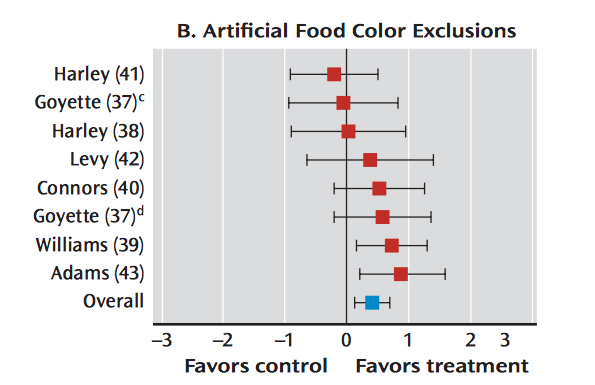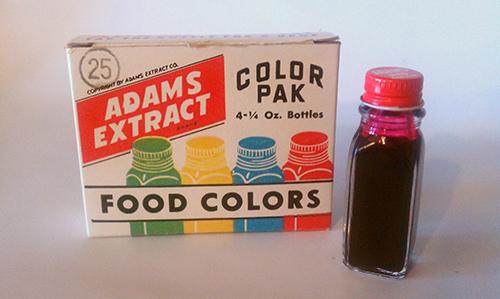Ask most chefs, and they will tell you, we begin eating with our eyes; how food looks impacts our perception of taste and the enjoyment of eating. But if the Center for Science in the Public Interest (CSPI) has its way, some types of food coloring will be banned. CSPI puts forward its argument for such a ban in a report entitled Seeing Red, a slick marketing of ideas that blend health studies with some misdirection and an agenda to “revoke approval for all food dyes.”
Their concern, in ‘protecting’ us, are the children more particularly children with Attention Deficient Hyperactivity Disorder (ADHD). ADHD is not a disease with objective biochemical or radiologic findings like a myocardial infarction or pneumonia, it is, and I am quoting from a paper CSPI cites, “ADHD is a phenomenological, not causal, diagnosis.” It is a syndrome that has “many causes for a common phenotype,” so ADHD is tough to pin down diagnostically in some circumstances. And to give their concern a certain objective quality, they quote numbers and percentages. For example, “The same study estimated that as many as eight percent of children with ADHD may suffer symptoms directly related to synthetic food colorings…” 8 percent is a real number; it is concrete and presumably objective. But here is the complete statement from the study CSPI cites, “We calculated that 8% (24% × 33%) of children with ADHD may have symptoms related to food colors. A confidence interval around that figure could not be computed but would be large. …However, these effects were not specific to food colors. Studies that considered the question of specificity of effects concluded that children who react to food colors also react to other food ingredients.”
So that 8 percent begins to be a lot fuzzier and it includes children with sensitivities to other food ingredients – I believe that we are being misled as to the true extent of the population at risk.
CSPI goes on to couple the rising tide of children felt to have ADHD with increasing use of certified color additives. In fact, they again provide some numbers of average amounts ingested because one of their arguments is that the FDA use too small of a figure for amounts ingested. Seeing Red states that the daily per capita consumption of certified color additives (CCA) is about 67mg. (The calculation is based on the amount of CCA sold/U.S. population). But what is not made clear is that CCA is found in many products. According to the FDA, 3-5% is exported, 10% used in pharmaceuticals, 3% in cosmetics, 14% in pet foods, leaving 73% or 49 mg as the average per capita daily intake. At best, this shows the difficulties in accurately measuring our children’s intake, and at worst it is a bit of misdirection.
From this beginning, a litany of studies is condensed into pull quotes to support their narrative, that ADHD is exacerbated for some individuals by their ingestion of one of the seven CCAs. Consider the following taken from Seeing Red, ““A 2013 meta-analysis …when limited to only the “best probably blinded assessments,” the effects [of dietary and psychologic approaches to reduction in ADHD symptoms] remained statistically significant for only two treatments: diets that excluded artificial colors and diets supplemented with free fatty acids. (A third dietary treatment, a restricted elimination diet, was just shy of statistical significance.) The researchers concluded that excluding artificial food colors from the diet “appears[s] to have beneficial effects on ADHD symptoms,” but noted that the effect may be limited to ADHD patients with food sensitivities.”

The graph is taken from the study using a Forest plot to view the studies involving CCA exclusion. 6 of the eight studies have confidence levels touching the 0 line indicating that they cannot demonstrate a statistically significant benefit. Of the two remaining significant studies, the Williams study concludes “The results of this study offer data that a diet free of artificial flavors and colors results in a reduction of symptoms in some hyperactive children.” [Italics added] The Adams study used tartrazine, an uncertified version of FD&C Yellow #5, testing a compound not used in the United States. Only four of these studies looked solely at dietary interventions in the absence of medical management, if only these four studies are considered, the difference in control and treatment groups were, in the words of the authors “nonsignificant.”
And finally, sometimes CSPI just gets it wrong. “The agency [FDA] emphasized flaws in studies that diminished the reliability of positive findings but did not highlight flaws that reduced the ability of studies to find impacts on behavior. For example, many studies on dyes had small numbers of subjects and used small doses of dyes—weaknesses that could prevent the studies from detecting a true effect.
When such studies detect behavioral effects, it is all the more compelling that the effects are real." [Italics added] Sample size matters in statistics, a larger sample reduces error. Small studies especially when looking at a problem that impacts only 8% (their number, not mine) of a study population cannot reliably differentiate random from link.




